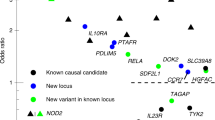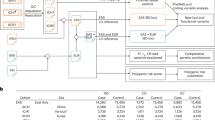Abstract
Genome-wide association scans (GWAS) using large case–control samples and several hundred thousand genetic markers have uncovered at least ten new genomic regions associated with susceptibility to Crohn disease, a chronic inflammatory bowel disorder. The new loci include genes with diverse roles in the immune response and several gene deserts, which may contain regulatory sequences or encode novel functional transcripts. The results so far suggest that genome scans may re-define our ideas on the nature of causal variants in complex disease.
This is a preview of subscription content, access via your institution
Access options
Subscribe to this journal
Receive 12 print issues and online access
$189.00 per year
only $15.75 per issue
Buy this article
- Purchase on Springer Link
- Instant access to full article PDF
Prices may be subject to local taxes which are calculated during checkout


Similar content being viewed by others
References
Podolsky, D. K. Inflammatory bowel disease. N. Engl. J. Med. 347, 417–429 (2002).
Hugot, J. P. et al. Association of NOD2 leucine-rich repeat variants with susceptibility to Crohn's disease. Nature 411, 599–603 (2001).
Ogura, Y. et al. A frameshift mutation in NOD2 associated with susceptibility to Crohn's disease. Nature 411, 603–606 (2001).
Hampe, J. et al. Association between insertion mutation in NOD2 gene and Crohn's disease in German and British populations. Lancet 357, 1925–1928 (2001).
Rioux, J. D. et al. Genetic variation in the 5q31 cytokine gene cluster confers susceptibility to Crohn disease. Nature Genet. 29, 223–228 (2001).
Stoll, M. B. et al. Genetic variation in DLG5 is associated with inflammatory bowel disease. Nature Genet. 36, 476–480 (2004).
Gaya, D. R., Russell, R. K., Nimmo, E. R. & Satsangi, J. New genes in inflammatory bowel disease: lessons for complex diseases? Lancet 367, 2372–1284 (2006).
Risch, N. & Merikangas, K. The future of genetic studies of complex human diseases. Science 273, 1516–1517 (1996).
Barrett, J. C. & Cardon, L. R. Evaluating coverage of genome-wide association studies. Nature Genet. 38, 659–662 (2006).
Pe'er, I. et al. Evaluating and improving power in whole-genome association studies using fixed marker sets. Nature Genet. 38, 663–667 (2006).
Hirschhorn, J. N. & Daly, M. J. Genome-wide association studies for common diseases and complex traits. Nature Rev. Genet. 6, 95–108 (2005).
Balding, D. J. A tutorial on statistical methods for population association studies. Nature Rev. Genet. 7, 781–791 (2006).
Yamazaki, K. et al. Single nucleotide polymorphisms in TNFSF15 confer susceptibility to Crohn's disease. Hum. Mol. Genet. 14, 3499–3506 (2005).
Duerr, R. H. et al. A genome-wide association study identifies IL23R as an inflammatory bowel disease gene. Science 314, 1461–1463 (2006).
Rioux, J. D. et al. Genome-wide association study identifies new susceptibility loci for Crohn disease and implicates autophagy in disease pathogenesis. Nature Genet, 39, 596–603 (2007).
Hampe, J. et al. A genome-wide association scan of non-synonymous SNPs identifies a susceptibility variant for Crohn disease in ATG16L1. Nature Genet. 39, 207–211 (2007).
Libioulle, C. et al. Novel Crohn disease locus identified by genome-wide association maps to a gene desert on 5p13.1and modulates expression of PTGER4. PLoS Genetics 3, 0538–0543 (2007).
Franke, A. et al. Systematic association mapping identifies NELL1 as a novel IBD disease gene. PLoS ONE 8, 1–13 (2007).
Wellcome Trust Case Control Consortium. Genome-wide association study of 14,000 cases of seven common diseases and 3,000 shared controls. Nature 447, 661–678 (2007).
Parkes, M. et al. Sequence variants in the autophagy gene IRGM and multiple other replicating loci contribute to Crohn's disease susceptibility. Nature Genet. 39, 830–832 (2007).
Raelson, J. V. et al. Genome-wide association study for Crohn disease in the Quebec founder population identifies multiple validated disease loci. Proc. Natl Acad. Sci. USA, 104, 14747–14752 (2007).
Prescott N. J. et al. A non-synonymous SNP in ATG16L1 is a risk factor for ileal Crohn's disease and is independent of CARD15 and IBD5. Gastroenterology 132, 1665–1671 (2007).
Tremelling, M. et al. IL23R variation determines susceptibility but not disease phenotype in inflammatory bowel disease. Gastroenterology 132, 1657–1664 (2007).
Cargill, M. et al. A large-scale genetic association study confirms IL12B and leads to the identification of IL23R as psoriasis-risk genes. Am. J. Hum. Genet. 80, 273–290 (2007).
Economou, M., Trikalinos, T. A., Loizou, K. T., Tsianos, E. V. & Ioannidis, J. P. Differential effects of NOD2 variants on Crohn's disease risk and phenotype in diverse populations: a meta-analysis. Am. J. Gastroenterol. 99, 2393–2404 (2004).
Fritz, J. H., Ferrero, R., L., Philpott, D. J. & Girardin, S. E. Nod-like proteins in immunity, inflammation and disease. Nature Immunol. 7, 1250–1257 (2006).
Chamaillard, M. et al. Gene–environment interaction modulated by allelic heterogeneity in inflammatory diseases. Proc. Natl Acad. Sci. USA 100, 3455–3460 (2003).
Neurath, M. F. IL-23: a master regulator in Crohn disease. Nature Med. 13, 26–28 (2007).
Xavier, R. J. & Podolsky, D. K. Unravelling the pathogenesis of inflammatory bowel disease. Nature 448, 427–434 (2007).
Deretic, V. Autophagy as an immune defense mechanism. Curr. Opin. Immunol. 18, 375–382 (2006).
Schmid, D., Dengjel, J., Schoor, O., Stevanovic, S. & Münz, C. Autophagy in innate and adaptive immunity against intracellular pathogens. J. Mol. Med. 84, 194–202 (2006).
Singh, S. B., Davis, A. S., Taylor, G. A. & Deretic, V. Human IRGM induces autophagy to eliminate intracellular mycobacteria. Science 313, 1438–1441 (2006).
Mascheretti, S. et al. Response to infliximab treatment in Crohn's disease is not associated with mutations in the CARD15 (NOD2) gene: an analysis in 534 patients from two multicenter, prospective GCP-level trials. Pharmacogenetics 12, 509–515 (2002).
Vermeire, S. et al. NOD2/CARD15 does not influence response to infliximab in Crohn's disease. Gastroenterology 123, 106–111 (2002).
Mannon, P. J. et al. Anti-Interleukin-12 antibody for active Crohn's disease. N. Engl. J. Med. 351, 2069–2079 (2004).
Marchini, J., Howie, B., Myers, S., McVean, G. & Donnelly, P. A new multipoint method for genome-wide association studies by imputation of genotypes. Nature Genet. 39, 906–913 (2007).
Yamazaki, K. et al. Association analysis of genetic variants in IL23R, ATG16L1 and 5p13.1 loci with Crohn's disease in Japanese patients. J. Hum. Genet. 52, 575–583 (2007).
The ENCODE Project Consortium. Identification and analysis of functional elements in 1% of the human genome by the ENCODE pilot project. Nature 447, 799–815 (2007).
Dermitzakis, E. T., Reymond, A. & Antonarakis, S. E. Conserved non-genic sequences — an unexpected feature of mammalian genomes. Nature Rev. Genet. 6, 151–157 (2005).
International HapMap Consortium. A haplotype map of the human genome. Nature 437, 1299–1320 (2005).
Acknowledgements
I would like to thank my colleagues from King's College, London, for comments on this manuscript, and the UK Inflammatory Bowel Disease Genetics Consortium and the Wellcome Trust Case Control Consortium, with whom I worked on the genome-wide scan in Crohn disease.
Author information
Authors and Affiliations
Related links
Related links
DATABASES
OMIM
FURTHER INFORMATION
Glossary
- Haplotype
-
The arrangement of the alleles of a series of neighbouring SNPs on the same chromosome.
- Ileum
-
The lower end of the small intestine.
- Linkage disequilibrium
-
A correlation between nearby variants such that the alleles at neighbouring SNPs are non-randomly associated within a population.
- Major histocompatibility complex
-
A highly polymorphic region on chromosome 6 that contains many genes involved in the immune response.
- Odds ratio
-
A measurement of association that is commonly used in case–control studies. It is defined as the odds of exposure to the susceptible genetic variant in cases compared with that in controls. If the odds ratio is significantly greater or less than one, then the genetic variant is associated with the disease.
- Tiling microarray
-
A microarray that carries a set of DNA probes that are complimentary to a series of separate or overlapping DNA sequences across a genomic region. Hybridization of fluorescently labelled cDNA from tissue or cells of interest to the array will detect any transcripts in the genomic regions that are represented by the probes.
Rights and permissions
About this article
Cite this article
Mathew, C. New links to the pathogenesis of Crohn disease provided by genome-wide association scans. Nat Rev Genet 9, 9–14 (2008). https://doi.org/10.1038/nrg2203
Issue Date:
DOI: https://doi.org/10.1038/nrg2203
This article is cited by
-
The gut mycobiota: insights into analysis, environmental interactions and role in gastrointestinal diseases
Nature Reviews Gastroenterology & Hepatology (2019)
-
Transplanted human fecal microbiota enhanced Guillain Barré syndrome autoantibody responses after Campylobacter jejuni infection in C57BL/6 mice
Microbiome (2017)
-
Common NOD2/CARD15 and TLR4 Polymorphisms Are Associated with Crohn’s Disease Phenotypes in Southeastern Brazilians
Digestive Diseases and Sciences (2016)
-
Very Early Onset Inflammatory Bowel Disease Associated with Aberrant Trafficking of IL-10R1 and Cure by T Cell Replete Haploidentical Bone Marrow Transplantation
Journal of Clinical Immunology (2014)
-
Current concepts on primary open-angle glaucoma genetics: a contribution to disease pathophysiology and future treatment
Eye (2012)



